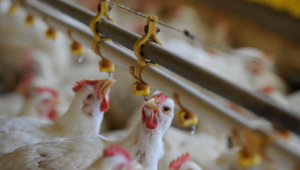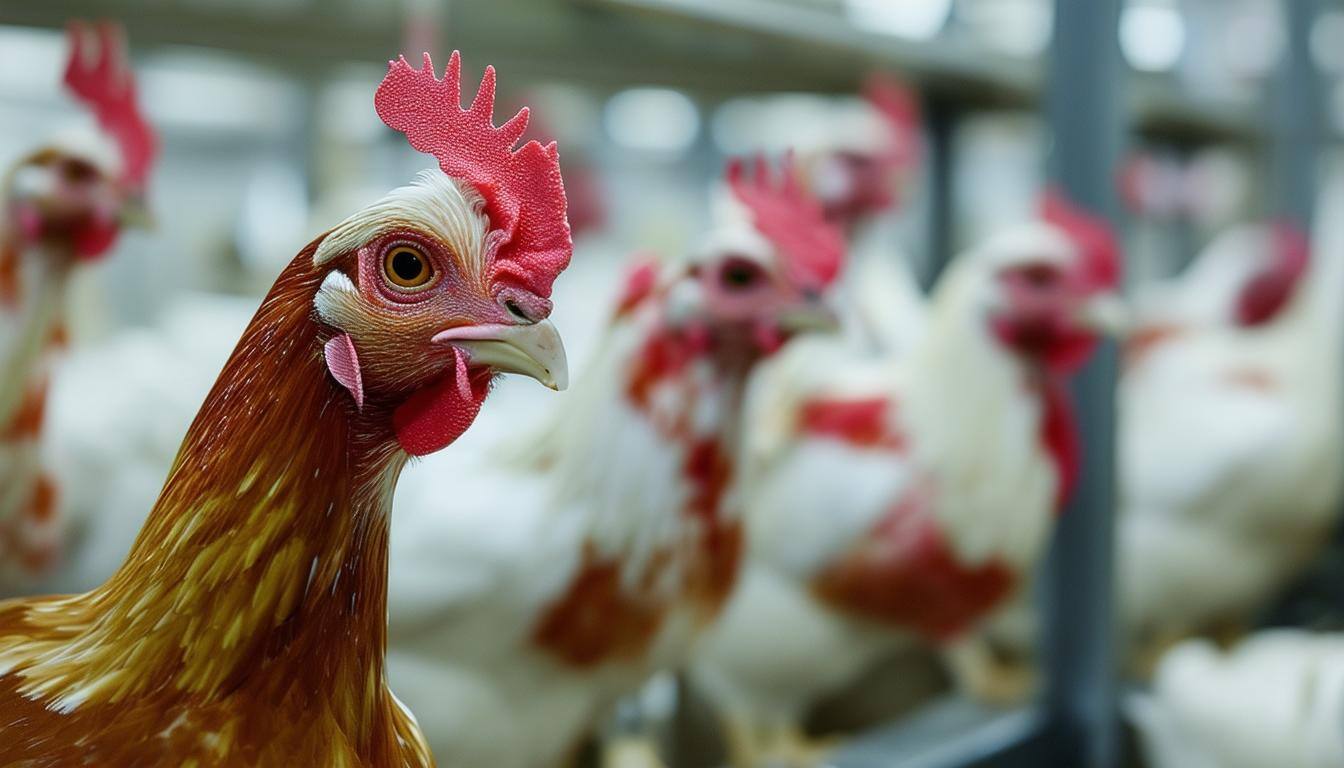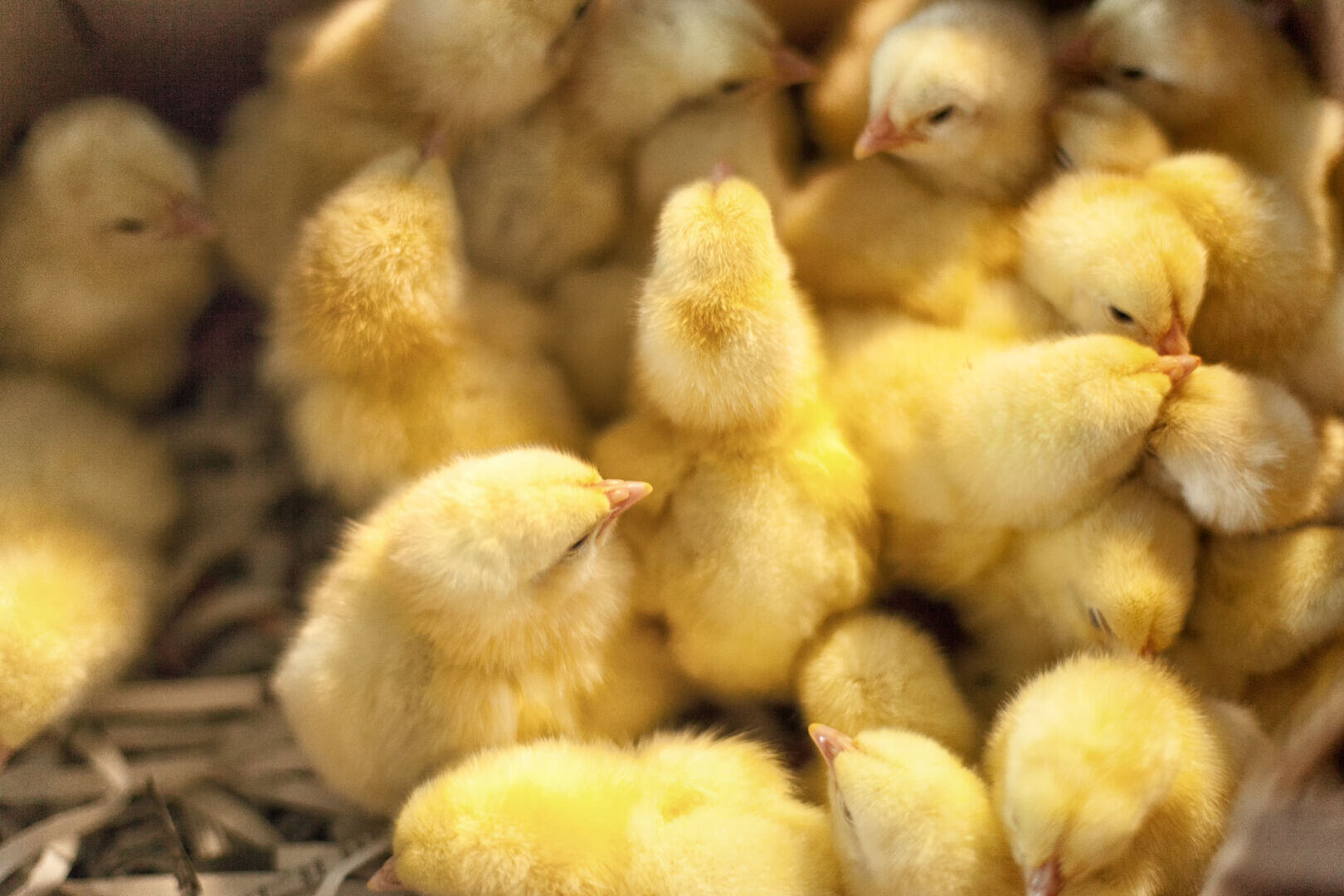Newcastle Disease

Mustafa Seçkin SANDIKLI
23 décembre 2025
Read it in minutes
INTRODUCTION
Since it was first officially reported in 1926, Newcastle disease (ND) has established as a major disease threat for commercial poultry including chickens, turkeys, quails, pheasants, as well as for hobby and zoo birds.
The disease was discovered in Indonesia in 1926, but is named after Newcastle-onTyne, England, where it occurred in 1927. It is also called ranikhet, pseudo-fowl pest, and avian pneumo-encephalitis.
Newcastle disease is caused by a virus belonging to the family of Paramyxoviridae; it is an avian paramyxovirus of serotype 1 (APMV-1). It affects wild birds and domestic poultry and usually presents as a respiratory disease. Depression, nervous manifestations, or diarrhea may also be the predominant clinical symptoms and mortality. It is an officially regulated disease and, in its velogenic form, must be officially reported to the OIE (OIE Terrestrial Animal Health Code). It also has a zoonotic dimension since initial exposure to infectious material can induce transient and benign conjunctivitis in humans in case of close contact.
Newcastle Disease (ND) is a highly contagious disease that varies widely in the type and severity of symptoms. It is one of the main barriers to international trade of poultry and poultry products and the economic impact of this disease is enormous.
ND is a notifiable disease to the World Animal Health Organization (OIE), a global risk analysis can be done. It enables to distinguish high challenge (where ND outbreaks are frequent) from low challenge countries.

In high challenge countries, when industrial chickens are experiencing an ND outbreak, they would display high mortality (up to 100%), high morbidity, listlessness, dyspnea, diarrhea, sometimes nervous signs (eg, torticollis, ataxia). At necropsy, internal organs are usually heavily hemorrhagic, especially the proventriculus, the cecal tonsils, the duodenum, the trachea, the brain.
In low challenge countries, industrial chickens are often facing the uncontrolled circulation of lentogenic (vaccine) strains, especially in high densely populated poultry areas. As a result, they may show subtle to overt respiratory signs, because of the inflammation of the trachea. It may worsen in case of suboptimal husbandry conditions (too high stocking density, high ammonia level, wet litter, poor ventilation). As a result, flock uniformity will decrease, and secondary opportunistic respiratory infections (eg, E.coli) may arise with the need to apply antibiotic medication. Ultimately, slaughterhouse condemnations may increase due to excessive airsacculitis.
Today the situation is that despite being known for 90 years, ND still poses huge threats to poultry producers, in enzootic areas as well as in regions or countries considered as free. The result is that better solutions are required regarding both implementations of biosecurity procedures and the availability of more efficacious vaccine solutions if the poultry industry wants to have real control of this disease.
Spotting Newcastle Disease
Newcastle Disease symptoms can be respiratory, nervous, intestinal symptoms for both clinical and subclinical infections.
ND can be classified into five different categories:
■ Viscerotropic velogenic, a highly pathogenic form in which hemorrhagic intestinal lesions are frequently seen.
■ Neurotropic velogenic, a form that presents with high mortality, usually following respiratory and nervous signs.
■ Mesogenic, a form that presents with respiratory signs, occasional nervous signs, but low mortality.
■ Lentogenic or respiratory, a form that presents with a mild or subclinical respiratory infection.
■ Asymptomatic: a form that usually consists of subclinical enteric infection.
How does ND Spread?
Wild bird populations play an important role in a reservoir of NDV as well as pigeons, backyard, and small-scale farming operations that maintain the infection. Besides, the tradition of live bird markets, cockfighting competitions, smuggling of domestic, zoo, or wild birds participate in the spreading of the virus. Even if poorly documented (especially for pigeons) all of these populations are reservoirs of NDV and important factors explaining why NDV is persisting, where it comes from, how it circulates. It also explains why no region, no country, no poultry operation can be considered as no risk.
However, it is undeniable that the major source of virus to healthy flocks is represented by diseased flocks housed in the same farm or in the neighborhood.
NDV is excreted from infected birds into the environment through exhaled air, respiratory discharges, and feces and can infect susceptible chickens by aerosols or by ingestion of contaminated feed or water. Its resistance in the environment is rather poor and this explains why cleaning and disinfection are so important.
The possibility of a true vertical transmission has been debated. A few cases have been reported in the scientific literature as well as convincing field observations. The contamination of newly hatched chicks would occur by surface contaminated eggs, or contaminated feces through eggshell cracks, or by exposure to a contaminated environment. However, NDV infection is known to be lethal for the embryo.
Consequently, until further clarification, the wisest way is probably to follow the recommendations of the Terrestrial Code of the OIE (article 10.13.8.) stating that poultry hatching eggs should be derived from parent flocks that have been kept in an ND-free country, zone, or compartment for at least 21 days prior to, and at the time of, the collection of the eggs.
As with avian influenza, limited evidence associating natural infection with the transmission in hatching eggs suggests that these recommendations of the OIE are clearly adequate to prevent the international dissemination of NDV.
Control of Newcastle Disease
Despite many years of enforcement of international and national trading regulations, the introduction of the biosecurity concept, harmonization, and spreading of laboratory diagnostic and monitoring techniques, implementation of vaccination programs, ND is still listed among the most damaging poultry diseases considering both clinical and economical consequences.
Some regions or countries like Western Europe, the USA, Brazil, etc. have successfully reduced and even phased out the incidence of the disease so that ND is nowadays considered only an epizootic risk. The vaccination programs, if applied, are always of the “light” type. (“low challenge areas”).
On the contrary, many countries from Latin America, Eastern Europe, Africa, the Middle East, and Asia are still cohabiting with the enzootic form of the disease with continuous waves of unavoidable pressure regularly plaguing them. In these countries, vaccination is considered a routine obligation guided by modest ambitions that are simply restricted to ensuring clinical and economical protection in case of challenge (“high challenge areas”).
Wild bird populations of backyard poultry, small-scale farming operations, and traditional live bird markets ensure the spreading of the ND virus and are important factors explaining where the disease comes from and how it circulates throughout the world.
But ND is also seen, even today, in poultry producing operations that are much better organized, following stringent biosecurity rules and often applying an intensive vaccination program. In fact, this has been a frustrating paradox that has really drawn the attention of veterinarians and production managers until the concept of flock monitoring and flock profiling has become popular.
As a consequence, NDV antibody testing conducted on samples taken from broilers at the end of the growing period or during the production phase in layers has revealed the frequent presence of low antibody positive, or even fully antibody-negative flocks in spite of (sometimes) very intensive vaccination programs including one or more inactivated and several live attenuated Newcastle Disease vaccines.
OIE guidelines for surveillance and disease eradication have been used to eliminate ND from many countries.
However, despite being recognized for almost 90 years, ND is caused by one single serotype of paramyxovirus and having commercially available very efficient vaccines, ND still challenges veterinarians and farmers all around the world. In Asia, particularly, this disease is a constant threat to the profitability of the poultry industry and its proper prevention has become a crucial part of the biosecurity program of any farm.
Vaccination is an important part of the prevention program against this disease. However, in ND endemic countries, day-old chicks carry high levels of maternally derived antibodies that interfere with live as well as killed ND vaccines given at the hatchery up to a point where neutralization is complete and prevent any vaccine take. Furthermore, vaccinations conducted in the farms, either to avoid this early interference or to boost previous immunizations, are very often very poorly conducted. Finally, live attenuated vaccines that are the backbone of a broiler ND vaccination program may be responsible for lesions of the upper respiratory tract, post-vaccination, and rolling reactions that slow down the growth, worsen the flock’s uniformity and leave the chickens susceptible to other pathogens.
Within this context, a new generation of vaccines was needed and the vector technology with rHVT-F vaccines, such as Vectormune® ND, overcomes all these aforementioned hurdles.
In fact, a very significant investment was made by Ceva Animal Health to know and understand the potentialities of this new product. Scientific work inside as well as outside the company, in collaboration with independent research centers, was designed, organized, and conducted. The information related to the vaccine-induced immunity as well as tangible protection results far exceeded our expectations.

How Does Newcastle Disease Impact Production?
ND is still listed among the most damaging poultry diseases considering both clinical and economical consequences.
○ Can easily be complicated with Infectious Bronchitis and Avian Influenza. (We call a mutual conspiracy of respiratory viruses)
○ It also has a zoonotic dimension since initial exposure to infectious material can induce transient and benign conjunctivitis in humans in case of close contact.

The Economic Impact On production
In areas where ND is enzootic, losses attributable to this disease are commonly observed in the field. The mortality rates can reach up to 100% and usually happens between 21 and 28 days of age. Economic losses also include expenditures for extensive vaccination programs, monitoring assays, performance losses due to post-vaccination reactions, and subsequent supportive medications.
In fact, this severe economic impact is not only due to the direct losses in the farms (chickens, feed, vaccines, treatments, etc), but also to intangible costs related to lack of birds in the slaughterhouse and subsequently broken deals with customers.
Ultimately, this disease can also harm the company’s image. Even in countries free of the disease, there are losses of flocks’ performance due to the post-vaccination reactions caused by live attenuated ND vaccines.
The Economic Impact On-trade
In case a country free of Newcastle (and consequently with the ‘ND free status’ necessary for exporting) is declared infected with NDV, most of the importing countries would ban the imports with no delay. For major exporting countries, this has immediate and huge consequences.
In the United States of America, in November 1971, a major ND outbreak occurred in commercial flocks in southern California.
During the two-year effort, 1,321 infected and exposed flocks were identified and almost 12 million birds were destroyed. The costs with this operation were approximately USD 56 million. In October 2002, velogenic ND was confirmed in California, Nevada and Arizona,
Texas and New Mexico. This time, almost four million birds on 2,662 premises were depopulated and the costs associated with the eradication efforts reached USD 160 million.
In Brazil and the USA, nearly 32% and 19% of their total chicken meat production are exported, respectively, and these two countries trade almost 70% of the chicken meat in the world. It is difficult, if not impossible, to predict the potential economic losses ND could cause in these exporting countries as they would depend on several variables such as the extent of the outbreaks, affected regions, type of birds, how fast the disease is controlled, production costs and many others.
In 2013, Brazilian revenues with chicken meat exports reached nearly USD 8 billion. If in a hypothetical example, these exports were reduced by only 20% as a consequence of ND outbreaks, the direct losses of revenue would reach USD 1.6 billion. This value is 10 times higher than the published losses attributable to ND outbreaks in the USA in 2002.
Additionally, in developing countries, the constant losses attributable to ND severely affect the quantity and quality of the food for people on marginal diets. As a consequence, the economic impact of this disease should not only be measured in direct commercial losses but also, in some countries, as a constant threat to food security with a direct impact on human health and socioeconomic gains.
Conclusion
The poultry industry is changing extremely fast and its challenges have increased considerably over the years. For producers, efficiency, rather than a differentiating point, became a survival strategy.
Today, it is necessary to produce more with less’ and in a context of a challenging environment. In addition, high disease pressure, high stocking density in farms located in very densely populated areas, poorly qualified workers, the pressure to reduce the use of antibiotics, and others are daily challenges faced by all involved in this industry. Within this context, prevention of ND is just part of a bigger puzzle.
Old solutions are not necessarily suitable for this modern industry. The use of vaccines that are able to protect against challenges but induce extensive post-vaccination reactions and consequently losses in the processing plants can be harmful in an industry that operates with narrow profit margins. Even in countries or regions with very low ND field pressure, the circulation of mild live ND vaccines within the flocks or between flocks can be very detrimental to producers’ profitability. In this framework, the use of Vectormune® ND is also extremely beneficial to producers in low-challenge areas. The replacement of the live attenuated vaccines by this vector vaccine reduces the circulation of lentogenic NDV strains among chickens with consequent improvement in their performance. In high challenge areas, where ND outbreaks bring unacceptable losses, Vectormune® ND has proven marked superiority as compared to any conventional vaccine as it evades MDA-NDV, which can be applied in the hatcheries (i.e. well-controlled environment with well-trained workers), it induces long-lasting immunity and significantly reduces the shedding. In fact, this vector vaccine has all these advantages without inducing any post-vaccination reactions.
However, even counting with a safe and efficacious vaccine as Vectormune® ND, more than ever, it is necessary to have a holistic approach to the ND situation rather than focusing only on the micro-organism and/or the vaccine efficacy. It is also necessary to take into consideration the limits of biosecurity, the urgent need for farm workers training, the legislation, and, if possible, the eradication of this disease. Without such an ample approach, ND will continue to inflict enormous losses to producers for a long time to come.
A TECHNICAL ECONOMICAL BOOKLET OF
DIFFERENT ND VACCINATIONS
Please have a look at our Technical Economical Booklet for real field experiences and benefits of an adequate vaccine solution from Ceva with the comparison of other vaccines.ines.









